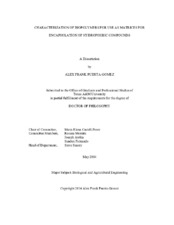| dc.contributor.advisor | Castell-Perez, Maria Elena | |
| dc.creator | Puerta-Gomez, Alex F. | |
| dc.date.accessioned | 2015-01-09T19:56:34Z | |
| dc.date.available | 2016-05-01T05:31:02Z | |
| dc.date.created | 2014-05 | |
| dc.date.issued | 2014-01-15 | |
| dc.date.submitted | May 2014 | |
| dc.identifier.uri | https://hdl.handle.net/1969.1/152441 | |
| dc.description.abstract | The high cost and potential toxicity of biodegradable polymers has increased the interest in natural and modified biopolymers as bioactive carriers. To design particles of small size characteristics, small dextrin (approximately15 nm) were prepared from waxy starches (WS) by enzymatic depolymerization with α-amylase of previous gelatinized WS granules. The small dextrin and phytoglycogen were converted to amphiphilic molecules by 3% and 7% octenyl succinate anhydrate (OSA) modification. Water sorption capability and the glass transition temperature (Tg) were associated with the physical stability of OSA-dextrin, OSA-phytoglycogen, and proteins like whey protein concentrate 80% (WPC), whey protein isolate (WPI), and α-lactalbumin (α-L). Depolymerization of WS incremented their water sorption capability and reduced the Tg at high relative humidity (RH) environment compared to native WS. The OSA modification did not change the adverse effect of depolymerization. The moisture sorption isotherm method could not accurately predict the effect of adsorbed water on the physical characteristics of the proteins, but it was consistent regarding the effect of plasticization by water adsorption on the Tg values of OSA-polysaccharides exposed to higher than 70% RH. The effectiveness of inexpensive encapsulating method based in self-assemble interaction of pure and combination of amphiphilic biopolymers in aqueous system was assessed using both fluorescent spectroscopy and rheological principles. Structure micelle-type formation of WPI (0.6 g/L) and α-lactalbumin (2.5 g/L) was determined by fluorescence. Different types of structure are formed by OSA-polysaccharides (10-20 g/L). Dynamic oscillatory tests at 0.01Pa, 23°C and neutral pH (7.0) using an analysis of the relaxation time “λ” value (G’/G”*ω), showed high sensitivity to type, concentration and combination of biopolymers. A distinguishable linear reduction of “λ” values (slope) up to a critical frequency value can be used as indicator of structure formation. Absorbance measurements (600 nm) were congruent with OSA-polysaccharides interaction-adsorption by electrostatically precipitated proteins and with the entrapment efficiency based on precipitated protein. The “λ” slope value approach demonstrates the possibility to evaluate the geometric aspect ratio of anisotropic particles formed from electrostatic precipitation of proteins alone or in combination with OSA-polysaccharides. This new rheological evaluation demonstrates the possibility to assess interactions of self-assembled amphiphilic biopolymers in aqueous solution. Electrostatic precipitation (pH=4.5) of protein alone or combined with OSA-polysaccharides was well-suited and it offers a safer alternative to entrap volatile and thermolabile compounds than the commonly used PLGA (poly (lactic-co-glycolic) acid). | en |
| dc.format.mimetype | application/pdf | |
| dc.language.iso | en | |
| dc.subject | Biopolymers | en |
| dc.subject | Rheology | en |
| dc.subject | encapsulation matrices | en |
| dc.subject | physical characterization | en |
| dc.subject | electrostatic precipitation | en |
| dc.subject | hydrophobic compounds | en |
| dc.title | Characterization of Biopolymers for Use as Matrices for Encapsulation of Hydrophobic Compounds | en |
| dc.type | Thesis | en |
| thesis.degree.department | Biological and Agricultural Engineering | en |
| thesis.degree.discipline | Biological and Agricultural Engineering | en |
| thesis.degree.grantor | Texas A & M University | en |
| thesis.degree.name | Doctor of Philosophy | en |
| thesis.degree.level | Doctoral | en |
| dc.contributor.committeeMember | Moreira, Rosana | |
| dc.contributor.committeeMember | Awika, Joseph | |
| dc.contributor.committeeMember | Fernando, Sandun | |
| dc.type.material | text | en |
| dc.date.updated | 2015-01-09T19:56:34Z | |
| local.embargo.terms | 2016-05-01 | |


